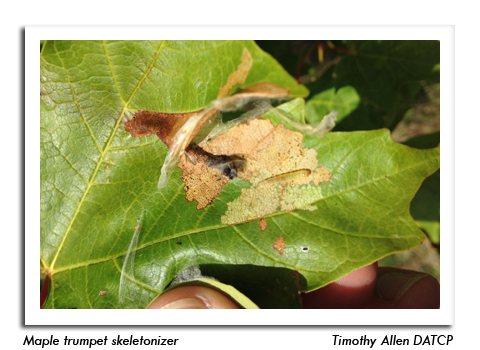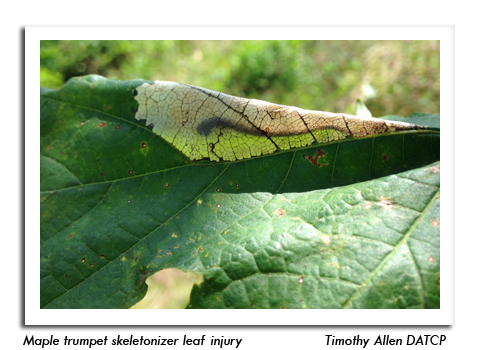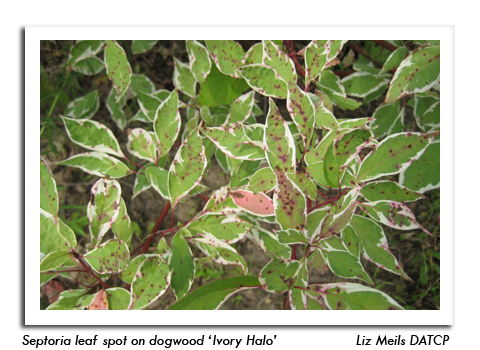
 |
|
|
Nursery & Forest
Volume 62 Number 18 Date 08/31/2017 SHOTHOLE BORER - The tiny circular holes evident on the bark of a pear tree in a southeast Wisconsin nursery were determined to be caused by the shothole borer, also known as the fruit tree bark beetle. This beetle lives beneath the bark and its larvae form distinctive galleries as they feed. The shothole borer is a native of Europe but now occurs throughout the U.S. and southern Canada where it attacks injured or stressed apple, cherry, pear and plum trees. Because chemical controls have not proven very successful, the best management approach is to keep trees healthy. Any infested trees or branches should be pruned and destroyed in winter to prevent beetles from emerging the following spring. MAPLE TRUMPET SKELETONIZER - Sugar maples in the Rhinelander area of Oneida County were showing trumpetlike tubes of frass and silk constructed by the maple trumpet skeletonizer. The larvae of this insect create a protective tube inside a folded maple leaf and feed on leaf tissue from mid-summer until fall. Mature caterpillars drop from the tube and form cocoons from pieces of leaves on the ground, eventually emerging as adults the following summer. The leaf damage caused by this insect appears late in the season and is normally not a threat to tree health. If aesthetics are a concern, affected leaves should removed and destroyed to reduce the number of reproducing adults in the area the following year. BOXWOOD PSYLLID - Boxwoods inspected at a nursery grower yard in Kenosha County last week were showing the characteristic leaf cupping symptoms indicative of feeding by boxwood psyllid. The cupped foliage is caused by the psyllid nymphs, which remain protected within the leaves and continue to feed throughout the season. Damage resulting from their feeding is usually minor and treatment is usually not needed. GUIGNARDIA LEAF BLOTCH - Symptoms of this common leaf blight were noticed by DATCP inspectors on horse chestnut trees last week in Racine and Washington counties. The leaves of affected plants develop large reddish brown blotches surrounded by yellow tissue, often causing the foliage to curl and brown. In severe cases, leaves may fall prematurely in late summer. Since the foliage is usually not seriously damaged until after the tree has completed much of its annual growth, the disease is primarily aesthetic. Disease development can be reduced by disposing of fallen leaves in autumn to decrease inoculum levels. LINDEN LEAF GALL MITE - The distinctive nail-shaped galls caused by this eriophyid mite were found on linden foliage in Oneida County. The galls usually form on the shaded, lower leaves and are the result of spring feeding by overwintered mites. Earlier in the season the galls are greenish yellow, but most begin to turn reddish-brown by fall. The linden leaf gall mite specializes on plants in the genus Tilia and occurs on littleleaf linden and basswood trees. Its damage is primarily a cosmetic nuisance and treatment is not required. SEPTORIA LEAF SPOT - This fungal leaf spot disease that commonly develops during the wet summer months has been observed in many nurseries throughout the state this season, particularly on dogwood. Septoria leaf spots are small, dark purple lesions that first appear on lower leaves, but may become so numerous that they cover the leaves by the end of summer. Heavily spotted leaves may be shed early. Promoting good air flow through proper plant spacing is the simplest way to reduce the incidence of this common fungal disorder. Cleaning up and disposing of fallen leaves on the ground and on infected trees or shrubs is also recommended. -- Timothy Allen, DATCP Nursery Inspector 





|
|
|